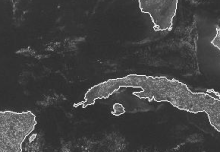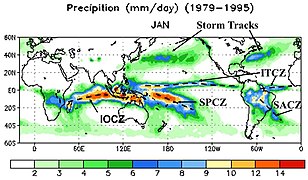Convergence zone

Aconvergence zoneinmeteorologyis a region in theatmospherewhere twoprevailingflows meet and interact, usually resulting in distinctiveweather conditions.[1] This causes a mass accumulation that eventually leads to a vertical movement and to the formation ofcloudsandprecipitation.[1]Large-scale convergence, calledsynoptic-scaleconvergence, is associated withweather systemssuch asbaroclinic troughs,low-pressure areas,andcyclones.The large-scale convergence zone formed over the equator, theIntertropical Convergence Zone,has condensed and intensified as a result of the global increase in temperature.[2]Small-scale convergence will give phenomena from isolatedcumulus cloudsto large areas ofthunderstorms.
The inverse of convergence is divergence, such as thehorse latitudes.
Large scale
[edit]
An example of a convergence zone is theIntertropical Convergence Zone(ITCZ), alow pressure areawhich girdles theEarthat theEquator.[3]Another example is theSouth Pacific convergence zonethat extends from the westernPacific OceantowardFrench Polynesia.

TheIntertropical Convergence Zoneis the result of the northeasterlytrade windsand southeasterly trade winds converging in an area of highlatent heatandlow pressure.[3]As the two trade winds converge, the cool, dry air collects moisture from the warm ocean and rises, contributing to cloud formation and precipitation. The low pressure area that is created by the movement of the trade winds acts as avacuum,drawing in the cooler, dry air from high pressure areas (divergence zones), creating a convection cell commonly known as theHadley Cell.[3]
Sea surface temperatureis directly related to the position of the Sun or the location of the "energy fluxequator, "thus theITCZshifts corresponding to the seasons.[3]Due to the position of the Sun, the sea surface temperature near the equator (30°S to 30°N), during anequinox,is higher than any other latitudes.[4]During thesummer solsticein theNorthern Hemisphere(June 21), theITCZis shifted north, following the position of the Sun.[5]TheITCZis shifted farther south during thewinter solstice(in the Northern Hemisphere), when the solar radiation is focused at 23.5°S.
Mesoscale
[edit]Convergence zones also occur at a smaller scale. Convergence lines form rows of showers or thunderstorms over a more local area.Sea breezescollidingcan trigger development of a convergence line. The heavy rain caused in a short period of time can cause severe flooding.[6]
Some examples are thePuget Sound Convergence Zonewhich occurs in thePuget Soundregion in the U.S. state ofWashington;Mohawk–Hudson convergencein the U.S. state ofNew York;theElsinore Convergence Zonein the U.S. state ofCalifornia;theBrown Willy effectwhich can be generated when south-westerly winds blow overBodmin MoorinCornwall;and thePembrokeshire Danglerwhich can form when northerly winds blow down theIrish Sea.Flooding in Boscastle,Cornwall, England in August 2004 was the result of thunderstorms developing on a convergence line.[6]
References
[edit]- ^ab LEUNG Wai-hung (June 2010)."Meteorology Basics: Convergence and Divergence".Hong Kong Observatory.RetrievedNovember 25,2015.
- ^Byrne, Michael P.; Pendergrass, Angeline G.; Rapp, Anita D.; Wodzicki, Kyle R. (2018). "Response of the Intertropical Convergence Zone to Climate Change: Location, Width, and Strength".Current Climate Change Reports4:355-370.doi:10.1007/s40641-018-0110-5
- ^abcdWaliser, D.E.; Jiang, X. (2015). "Tropical Meteorology and Climate: Intertropical Convergence Zone".Reference Module in Earth Systems and Environmental Sciences6(2): 121-131.doi:10.1016/B978-0-12-382225-3.00417-5
- ^Krishnamurti, T.N.; Stefanov, Lydia; Misra, Vasubanhu (2013).Tropical Meteorology: An Introduction.New York, New York: Springer Science & Business Media.ISBN978-1-4614-7409-8doi:10.1007/978-1-4614-7409-8
- ^Schneider, Tapio; Bischoff, Tobias; Haug, Gerald H. (2014). "Migrations and dynamics of the Intertropical Convergence Zone."Nature513:45–53.doi:10.1038/nature13636
- ^abWooltorton, Jodie (17 August 2021)."Weatherwatch: a meeting of winds in convergence zones".The Guardian.
